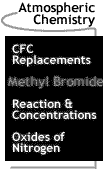

 |
Atmospheric Chemistry: Methyl Bromide Methyl bromide (CH3Br) is responsible for 5% to 10% of ozone destruction. It is a very effective pesticide and is used heavily in the U.S. Currently 76,000 tons per year is used worldwide. Two-thirds of that is used in the developed countries of North America and Europe. The Montreal Protocol does not require a reduction in industrialized countries usage until the year 2001, when the allowable amount will decrease to 25%. Usage is banned completely in industrial countries by 2010 and frozen in developing countries by 2002. In the U.S., production and import are banned by 2001.
10% of the worldwide use of methyl bromide takes place in California. A statewide ban on the use of methyl bromide was to be implemented on March 1, 1996, but a special session of the legislature extended the deadline. While the use of methyl bromide was being extended in California, groups were pushing for the amendment of the Montreal Protocol in order to speed up the phaseout of methyl bromide. Since methyl bromide is a very effective pesticide and is used for a wide variety of purposes, scientists are searching for acceptable substitutes. Right now, methyl iodide (CH3I) looks promising. It has a short life and is not thought to be an ozone depletor.
[ Atmospheric Physics ] [ Atmospheric Chemistry: CFC Replacements / [ Home ] [ Teacher Pages ] [ Modules & Activities ] |
HTML code by Chris Kreger
Maintained by ETE Team
Last updated April 28, 2005
Some images © 2004 www.clipart.com
Privacy Statement and Copyright © 1997-2004 by Wheeling Jesuit University/NASA-supported Classroom of the Future. All rights reserved.
Center for Educational Technologies, Circuit Board/Apple graphic logo, and COTF Classroom of the Future logo are registered trademarks of Wheeling Jesuit University.